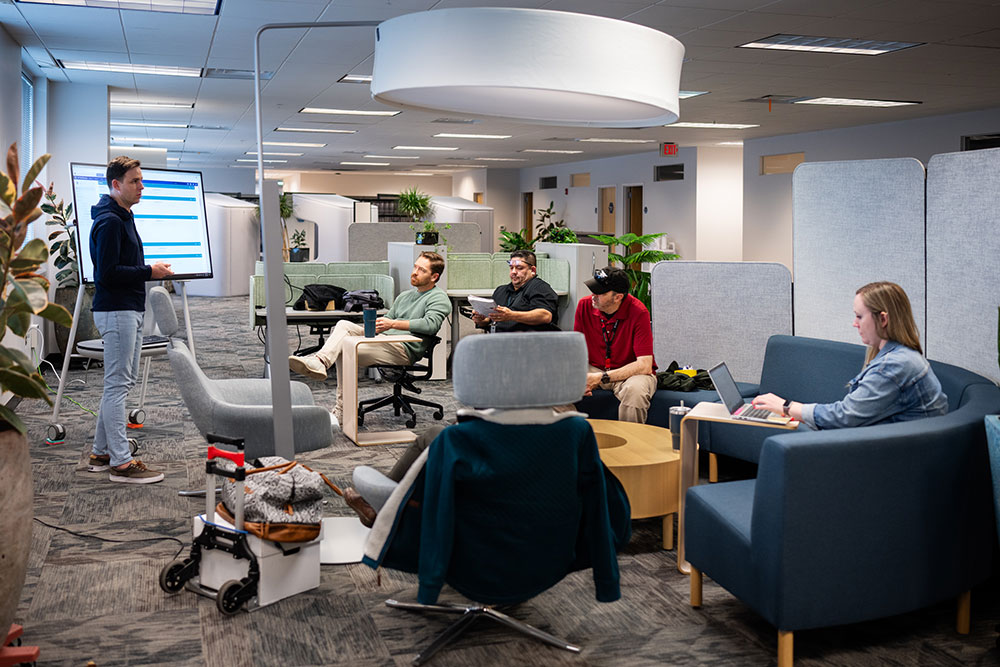
When COVID-19 sent the world home in 2020, everyone faced unexpected challenges while finding new ways to get work done. One such challenge was how to productively meet without being in the same physical space.
Today, around 4,000 Sandians are working remotely or telecommuting, and that challenge continues. Two Sandians leaned into their Toastmasters training and recently offered some strategies during a presentation to the Sandia Women’s Action Network, to help navigate this newly evolving work environment.
Barbara Lewis and Laura Lovato are both veterans of one of the Toastmasters International clubs that meets at Sandia and say their training has been instrumental to presenting ideas well. Laura said Toastmasters is much more than learning to speak in front of an audience.
“Some people will say, ‘I don’t need to go to Toastmasters, I already can speak in front of a crowd.’ But it’s more about effective speaking, especially when you need to sell an idea, and you need to get buy-in regarding that idea. How effective are you? Are you concise?” Laura said, adding that, given the propensity for good listeners to become good leaders, the organization also helps build strong leadership skills.
During their presentation, Laura and Barbara start with the basics.
“We go over how to have an effective meeting, first and foremost, because if you can’t have an effective in-person meeting, you can’t have an effective virtual or hybrid meeting,” Barbara said.
A big part of that, particularly when screens are involved, is to condense the content so it is more easily retained. For an hourlong meeting, use the first 10 minutes to go over what the goals of the meeting are, ideally have three main points to cover, and reserve the last 10 minutes to discuss takeaways and action items so everyone understands the next steps.
Laura and Barbara encourage presenters to explain the ground rules up front, so people know what to expect. If the meeting should be interactive, let attendees know at the beginning to plan their questions or expect to be called on if participation is lagging. They highly encourage participants, when security allows, to turn on their cameras, citing better opportunities for connection as well as helping the audience stay focused. If people are on camera, they are more likely to stay present and resist the urge to move on to other work.
“In person, you’re making more of that connection, but how do we read body language, and how do we make sure people stay engaged? Cameras are the best way to do that,” Laura said.
Additionally, eye contact is a critical component of how humans communicate; some research indicates that eye contact and body language are more important than what is verbalized. It can feel unnatural online though. Participants look at the screen, making it hard to see their eyes. Barbara encourages speakers to look directly into their camera to make the interactions feel more personable and effective.
“One skill we’ve learned in Toastmasters is that eye contact is important,” Barbara said. “To really make eye contact — so that you feel that I’m making eye contact — you have to look at the camera.”

Both agree that hybrid meetings present some of the greatest challenges. “If you’re in a conference room with other people, you have the danger of ignoring the people coming in virtually. Or if most people are virtual, you might ignore the people in the room,” she said. The chat feature of online meetings presents another hurdle, as people in the room can’t see what is being said on chat, but they can hear the potentially distracting alerts.
To combat that, Laura offers a creative solution. She asks everyone to bring their laptops, even if they’re attending in-person. Participants will see a wide-angle view of the whole conference room, but they can also see one another and interact, regardless of where they are. Another strategy is to designate a chat monitor who can keep the presenter aware of questions coming in from those online.
They also suggest making purposeful use of the tools available, including polls, breakout rooms and whiteboards, but caution against overuse, as tools can also be distracting if used without discretion. When hosting a large meeting, they like to run a poll after a break to see how many people have returned.
Finally, for any presentation, whether in-person, online or a combination of the two, don’t be afraid of pauses. Allowing for several seconds of silence, particularly during a Q&A portion of a meeting, gives audience members the chance to collect their thoughts and ask meaningful questions. A good rule of thumb is to silently count to seven before moving to the next topic. “Some people will feel like it’s an eternity, and they feel like they can’t do it, but you need to pause,” Barbara said, adding that it gives time to ensure that everyone who wants to participate can.
If you would like to learn to improve your presentation, leadership and speaking skills, consider joining one of the Toastmasters International clubs that meet at Sandia. Meetings are regularly advertised in Sandia Daily News, or contact Barbara Lewis for more information.